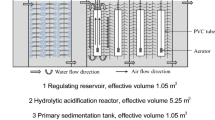Abstract
Diesel fuel spills have a major impact on the quality of groundwater. In this work, the performance of an Anaerobic Fluidized Bed Reactor (AFBR) treating synthetic wastewater is experimentally evaluated. The wastewater comprises tap water containing 100, 200 and 300 mg/L of diesel fuel and nutrients. Granular, inert, activated carbon particles are employed to provide support for biomass inside the reactor where diesel fuel is the sole source of carbon for anaerobic microorganisms. For different rates of organic loading, the AFBR performance is evaluated in terms of the removal of diesel fuel as well as chemical oxygen demand (COD) from wastewater. For the aforementioned diesel fuel concentrations and a wastewater flow rate of 1,200 L/day, the COD removal ranges between 61.9 and 84.1%. The concentration of diesel fuel in the effluent is less than 50 mg/L, and meets the Level II groundwater standards of the MUST guidelines of Alberta.






Similar content being viewed by others
References
Van Stempvoort DR, Lesage S, Novakowski KS, Millar K, Brown S, Lawrence JR (2000) Humic acid enhanced remediation of an emplaced diesel fuel source in groundwater. J Contam Hydrol 54:249–276
Health and Welfare Canada (1989) A report of the Federal-Provincial Advisory Committee on Environmental and Occupational Health. Rep. No. EHD-TR-156. Environmental Health Directorate, Ottawa
Agency for Toxic Substances and Disease Registry (ATSDR) (1990) Toxicological profile for polycyclic aromatic hydrocarbons. U.S. Department of Health and Human Services, Public Health Service. TP-90-20
Alberta MUST (1990) Draft subsurface remediation guidelines for Underground Storage Tanks-Draft. Environment Canada-Ontario Region for Federal Facilities operating in Ontario, http://www.on.ec.gc.ca/pollution/ecnpd/tabs/tab05-e.html
Environment Canada (1994) ETC Biennial Report, Environmental Technology Centre Report, Series No. DO 1-93/94, http://www.etc-cte.ec.gc.ca/publications/biennial/birep 1994_e.html#6.2 [Accessed 4 June 2004]
Rehm HJ, Reiff T (1981) Mechanism and occurrence of microbial oxidation of long chain alkanes. Adv Biochem Eng 19:175–215
Boopathy R (2003) Anaerobic degradation of No. 2 diesel fuel in the wetland sediments of Barataria-Terrebonne estuary under various electron acceptor conditions. Bioresour Technol 86:171–175
Bouwer EJ (1992) Bioremediation of organic contaminants in the subsurface. In: Mitchell R (ed) Environmental microbiology. Wiley, New York, pp 287–318
Atlas RM (1981) Microbial degradation of petroleum hydrocarbons: an environmental perspective. Microbiol Rev 45:180–209
Erickson M (2000) Biodegradation of hydrocarbons in soil and water. Ph.D. Thesis, Department of Biotechnology, Royal Institute of Technology, Stockholm, Sweden
Huesemann MH (1995) Predictive model for estimating the extent of petroleum hydrocarbon biodegradation in contaminated soils. Environ Sci Technol 29:7–18
So CM, Young LY (1999) Isolation and characterization of a sulfate-reducing bacterium that anaerobically degrades alkanes. Appl Environ Microbiol 65:2969–2976
Coates JD, Anderson RT, Woodward JC, Philips EJ, Lovley DE (1996) Anaerobic degradation in petroleum-contaminated harbor sediments under sulfate-reducing and artificially imposed iron-reducing conditions. Environ Sci Technol 30:2784–2789
Coates JD, Woodward J, Allen J, Philip P, Lovley DE (1997) Anaerobic degradation of polycyclic aromatic hydrocarbons and alkanes in petroleum-contaminated marine harbor sediments. Appl Environ Microbiol 63:3589–3593
Lovley DR, Lonergan DK (1990) Anaerobic oxidation of toluene, phenol, and p-cresol by the dissimilatory iron-reducing organisms GS-15. Appl Environ Microbiol 56:1858–1864
Suidan MT, Wuellner AM, Boyer TK (1991) Anaerobic treatment of a high strength industrial waste bearing inhibitory concentration of 1,1,1-trichloroethane. Water Sci Technol 23:1385–1393
Moteleb MA, Suidan MT, Kim J, Maloney SW (2002) Pertubated loading of a formaldehyde waste in an anaerobic granular activated carbon fluidized bed reactor. Water Res 36:3775–3785
Fox P, Suidan MT Bandy JT (1990) A comparison of media types in acetate fed expanded bed anaerobic reactors. Water Res 24:827–35
Flora JRV, Suidan MT, Wellner AM, Boyer TK (1993) Anaerobic treatment of a simulated high-strength industrial wastewater containing chlorophenols. Res J WEF 26:21–31
Baryshnikova LM, Grishchenkov VG, Arinbasarov MU, Shkidchenko AN, Boronin LM (2001) Biodegradation of oil products by individual degrading strains and their associations in liquid media. Appl Biochem Microbiol 37:463–468
Huang T, Wei F, Xu S, Gu Y, Qian S (1989) Application of GC/MS in the analysis of diaromatics, polyaromatics and polar compounds of light diesel oil from catalytic cracking. Shiyou Huagong 18:328–333
Blumer M (1976) Polycyclic aromatic compounds in nature. Sci Amer 234:35–45
Song Ch, Hsu ChS, Mochida I (2000) Chemistry of diesel fuels. Taylor & Francis, New York, pp 18
Maier RM, Pepper IL, Gerba CP (2000) Environmental microbiology. Academic, Boston
Miller KM, Suidan MT, Sorial GA, Khododoust AP, Acheson CM, Brenner RC (1998) Anaerobic treatment of soil wash fluids from a wood preserving site. Water Sci Technol 38:63–72
Fox P (1989) An innovative reactor design for the treatment of biologically inhibitory wastewater. Ph.D. Thesis, Department of Civil Engineering, University of Illinois Urbana-Champaign IL
APHA, AWWA, WPCF (1995) Standard methods for the examination of water and wastewater. In: Eaton AD, Clesceri LS, Greenberg AE (eds) 19th edn.Washington DC
Vezuli J (2004) Anaerobic degradation of diesel fuel contaminated wastewater in a fluidized bed reactor M.A.Sc. Thesis, Department of Chemical Engineering, Ryerson University Toronto
Author information
Authors and Affiliations
Corresponding author
Rights and permissions
About this article
Cite this article
Cuenca, M.A., Vezuli, J., Lohi, A. et al. Anaerobic biodegradation of diesel fuel-contaminated wastewater in a fluidized bed reactor. Bioprocess Biosyst Eng 29, 29–37 (2006). https://doi.org/10.1007/s00449-006-0053-4
Received:
Accepted:
Published:
Issue Date:
DOI: https://doi.org/10.1007/s00449-006-0053-4




